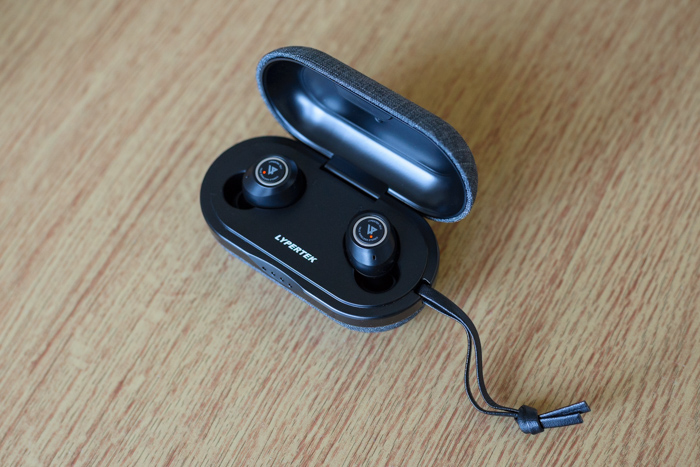Lypertek PurePlay Z3
Aesthetics and Build Quality:
The PurePlay Z3 (formerly known as TEVI) are a smooth and discreet, nothing really stands out on them with a small logo and silver trim ring on the faceplate. They smooth black finish looks great, there is a slight difference in colour between the 2 sections of the body but it doesn’t detract from the overall look.
Build quality is excellent, the joins in the housings are very smooth and they are finished to a high standard. The charging case is fabric coated and solid, and the buttons on the faceplates have a very positive click. Overall everything feels very well put together and durable for long term use. They are also IPX7 rated which means they are fine for your daily run and gym use.

Features:
The PurePlay Z3 use the latest Bluetooth 5.0 technology along with support for aptX, AAC and SBC codecs. Pair them with an aptX compatible device and you’ll get slightly better sound quality of course, but AAC also sounds very good.
The controls are easy to learn and intuitive, two click on the right to increase volume, two on the left to decrease. Three clicks on the right to skip track forward, three on the left to skip backwards. Single tap on either will pause the music, and a 2s press on the left will bring up Siri/Google assistant. You can also pick up calls and there are built in microphones that work very well.
Battery is rated at 10hrs per charge (SBC 50% volume), and I would say that figure is quite accurate from testing, using aptX will decrease this slightly but the increase in sound quality is worth the trade-off. The charging case supports another 6 whole charges, making these very impressive compared to the current competition.
Connectivity and signal stability are excellent, they pair easily and only cut out if you go out of range or add objects within the transmitting path (walls etc..). Overall, they work as advertised and don’t cut out if your phone is in your pocket or within a reasonable distance.
Comfort and Isolation:
The shape of the PurePlay Z3 is ergonomic with soft rounded edges and the perfect angle nozzle to provide a comfortable and secure fit without sticking out too far. The housings are a little on the larger size, but they never feel cumbersome when in use.
Isolation is pretty good; they do a very reasonable job at muting outside noises and are perfect for daily use and commuting.
Sound:
Bass: The bass on the PurePlay Z3 is full yet well controlled, it has a way of adding body without becoming the centre of attention. In terms of presence they are slightly north of neutral but they always sound very well balanced. There is good extension and kicks are backed up with body. The lows really are impressive, preventing the PurePlay Z3 from sounding thin but without making them sound bloated. They handle most genres with ease and have good articulation, lacking only a little speed during complex mixes.
Midrange: The lows are slightly north of neutral in terms of presence, but this does not mask the midrange and make vocals sound pushed back or congested. The midrange is well separated, lower male vocals do have a tiny bit of added body, and female vocals cut through with a little more detail but the overall midrange performance is very well balanced. Most consumer true wireless models have a habit of boosting the bass and treble, whereas the PurePlay Z3 comes across a lot more even handed and more suitable for a wide range of genres. There is great separation and layering, yet the coherency between frequencies is also excellent.
Treble: The treble is slightly laid back but luckily there is enough presence to prevent the PurePlay Z3 from sounding overly dark. The thing about the treble is that the tonality is just right, they don’t sound splashy or metallic and have great extension and detail. They have good accuracy when it comes to imaging too and they fit well into the frequency range. I would never call these bright though, and the treble is smooth enough that even the most treble sensitive users won’t have any issues with fatigue.
Soundstaging is good, not huge but very acceptable as most TW earphones sound very closed in. The detail present here is excellent and the separation between instruments is great.
Conclusion:
The PurePlay Z3 are very impressive, especially considering their sub £100 price point. Offering up a smooth and detailed sound signature that is well balanced yet slightly full. Add to that great stability and functionality and you have a TW earphone that is so easy to recommend, go out and grab one now as they are a game changer in the TW market.
Sound: 5/5
Comfort:5/5
Features: 5/5
Value: 5/5